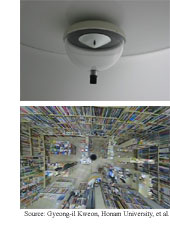|
NEWS
|
Mini artificial heart
A tiny rubber sphere surrounded by a layer of
heart muscle cells works as a microfluidic pump powered
only by the chemical nutrients feeding the cells. The
pump could be used to power medical implant devices without
the need for batteries or other external power sources.
(A
Micro-Spherical Heart Pump Powered by Cultured Cardiomyocytes,
Lab on a Chip, published online November 13, 2006)
Truer wide-angle lens
 A relatively simple wide-angle lens provides a
151-degree field of view without the distortions of traditional
fish-eye wide-angle lenses. The lens, made from a cone-shaped
mirror that reflects light onto a small lens, could be
used for indoor surveillance systems. (Wide-Angle
Catadioptric Lens with a Rectilinear Projection Scheme,
Applied Optics, December 1, 2006)
A relatively simple wide-angle lens provides a
151-degree field of view without the distortions of traditional
fish-eye wide-angle lenses. The lens, made from a cone-shaped
mirror that reflects light onto a small lens, could be
used for indoor surveillance systems. (Wide-Angle
Catadioptric Lens with a Rectilinear Projection Scheme,
Applied Optics, December 1, 2006)
Breathable rubber
A synthetic rubber mixed with liquid crystal molecules
contains infinitesimal channels that let diminutive water
molecules through but block larger molecules. The material
could be used to make protective suits that let water
vapor out while shielding wearers from hazardous substances.
(Crosslinked
Bicontinuous Cubic Lyotropic Liquid-Crystal/Butyl-Rubber
Composites: Highly Selective, Breathable Barrier Materials
for Chemical Agent Protection, Advanced Materials,
published online November 29, 2006)
Water tunes light chips
Photonic crystal materials whose tiny holes can
be filled with water form changeable chips for channeling
light waves. The chips could be used to make reconfigurable
devices that control optical communications signals. (Rewritable
Photonic Circuits, Applied Physics Letters,
November 20, 2006)
Steerable bacteria
Bacteria that contain magnetic particles can be
used to push microscopic beads to specific locations;
the bacteria are steered by magnetic fields generated
by electronic circuits placed beneath the bacteria. The
bacteria could be used to move objects in microfluidic
devices and to propel tiny machines in liquid environments.
(Controlled
Manipulation and Actuation of Micro-Objects with Magnetotactic
Bacteria, Applied Physics Letters, December
4, 2006)
Worms in a maze
A maze of tiny liquid-filled channels lets scientists
study the behavior of minuscule worms in the same way
biologists have studied rats and other animals for decades.
Research using the microfluidic maze shows that the common
nematode Caenorhabditis elegans tends to explore complex
spatial environments and can even be conditioned to look
for food in specific places. (Maze
Exploration and Learning in C. elegans, Lab
on a Chip, published online December 1, 2006) |
FEATURES
|
View
from the High Ground: ICL's John Pendry
Physics as machine tool, negative refractive
index, metamaterials, shattered wine glasses, higher capacity
DVDs, scientific backwaters, risk perception and practice,
practice, practice.
|
How
It Works: Quantum computing: qubits
Photons, electrons and atoms, oh my! These particles are
the raw materials for qubits, the basic building blocks
of quantum computers. |
|
 |
News RSS feed 
Blog RSS feed 
Bookshelf RSS feed

New: TRN's
Internet Services
TRN's Jobs Center
|
| |
|
| |
|
| |
"Physics
is to the rest of science what machine tools are
to engineering. A corollary is that science places
power in our hands which can be used for good or
ill. Technology has been abused in this way throughout
the ages from gunpowder to atomic bombs."
- John Pendry, Imperial College London |
|
| |
|
| |
Thanks
to Kevin from
GoldBamboo.com
for technical support |
|

